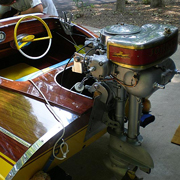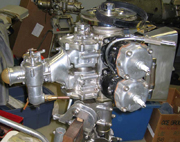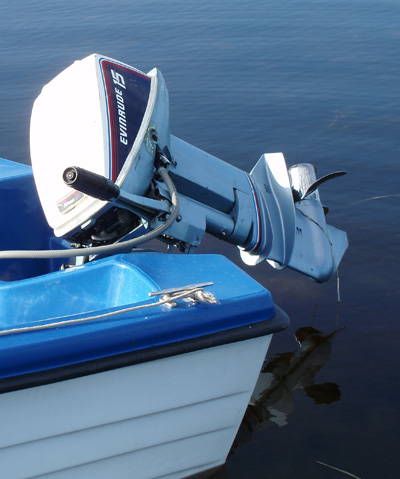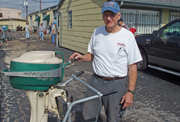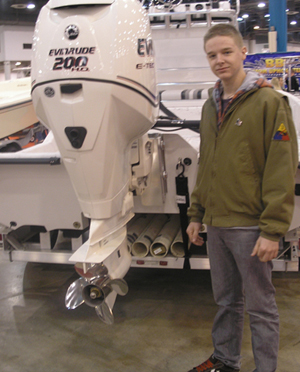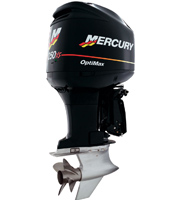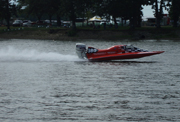Click on the tabs
to find out about different types of outboards
- Antiques
- Classics
- Moderns
Antique outboards, made until 1950, generally have rotary valves. Until the late 1940s they typically little or no cowling. They had no gearshift and generally did not have a rewind starter or remote fuel tank. The 'plumbing' was either fully or largely exposed.
There were many outboard manufacturers during that era, the only one to survive to the present is Evinrude. Evinrude and Johnson antiques are still relatively easy to find, many service and racing motors have been restored by AOMC members. With a single rotary valve, a pure racing motor either starts easily and idle well, or else runs well at high speed, but not both. Dual rotary valves were used in some motors, one for low and another for high speed.
The forward gear-only 16 hp Johnson SD series produced from about 1941-1949 is an example with dual rotary valves. Rotary valve motors were generally replaced after 1950 by reed-inducted motors, except for racing. Alcohol burning racing outboards (Rossi, Arens) still use rotary valves. OMC last included rotary valve inducted antiques in its lineup in 1950. The 1949-56 Champion outboards looked and ran like classics but had either single or dual rotary valves. Champion's fishing motors (through 16 hp) started easily and ran as well as a comparable OMC or Mercury. The Class B Champion Hot Rod successes forced Mercury to develop exhaust tuning for the Mark 20H.
Classics are those built since 1950, with exceptions. Mercury built a classic in 1941. A classic outboard generally has reed valves, is easy to start, idles well, and has the 'plumbing' covered by streamlined cowlings. Classic outboards are more or less those built from 1950-2001. All Mercurys from 1941 onward are have reed valves and are classics, but rewind starters were not standard on all models until the early 1950s. Scott-Atwater offered rewind starters, reed valves, and full gearshift in 1949.
The Mercurys and Scotts started easily, idled well and ran well at high speed. The first Johnson classic was the 10 hp QD series introduced in 1949. The first Evinrude classics were the 7.5 and 14hp models introduced in 1950. The 'JohnRude phenomenon', the same, identical OMC lineup with different cowls, did not emerge until 1956.
Some classics were fuel- or oil-injected but most were carbureted with oil mixed by hand in the gas tank. A very important change in the classic models appeared in 1968: OMC introduced a 55 hp model with exhaust tuning, V-block reeds, and loop charging. These features are now standard on modern outboards. V-block reeds were used in McCulloch Scotts in 1957, while the 1961 Merc 500 was the first production outboard with exhaust tuning. Exhaust tuning has an effect analogous to supercharging a 4-stroke motor. In a 2-stroke, sound waves are used to ram lost fuel-air mixture back into the cylinder just before the exhaust port closes. This is important for high performance, both for racing and meeting emissions standards. The loop-charged 3 cylinder 49.9 c.i. 1975 Johnson/Evinrude 75 was a faster motor than the 66 c.i. 4 cylinder cross-scavenged Mercury 850.
Modern 2-stroke outboards, the Mercury Optimax and Evinrude E-Tecs, are fully fuel and oil injected, and are loaded with sensors to meet emissions standards. The Evinrude E-Tec era began in 2002 with a lineup that ran from 75-250 hp and included only Ficht fuel-injected models. E-Tecs are completely electronic, have both oil and fuel injection and many emissions sensors. These ultra-modern 2-stroke outboards must be analyzed using a BRP program on a laptop. Hans, who's worked for Red Wing Boat Co. for less than a year can do this.
Outboards are unfortunately generally verboten in many areas of Germany and Austria. European Union emissions standards are (too) strict. The Evinrude E-Tec meets the EU standards, and in addition is so clean that it's permitted on the large Swiss-German-Austrian border lake Bodensee. Even the German water police use the E-Tec. Unfortunately, Mercury's fine Optimax did not meet the EU emissions standards.
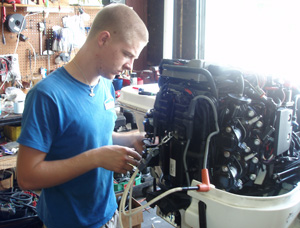 Hans learned to trouble shoot the new direct-injected Evinrudes using a laptop with BRP program.
Due to meeting the U.S. and E.U. emissions standards these motors are very advanced. Unlike
a car, when you install a new fuel injector then the timing of the injector must be set using the laptop
and program. In contrast, with an older carbureted motor with electronic ignition, you can troubleshoot the entire
ignition system except the powerpack with a ohm meter and volt meter.
Hans learned to trouble shoot the new direct-injected Evinrudes using a laptop with BRP program.
Due to meeting the U.S. and E.U. emissions standards these motors are very advanced. Unlike
a car, when you install a new fuel injector then the timing of the injector must be set using the laptop
and program. In contrast, with an older carbureted motor with electronic ignition, you can troubleshoot the entire
ignition system except the powerpack with a ohm meter and volt meter.


